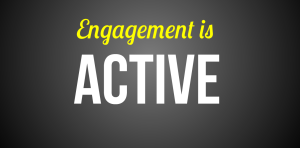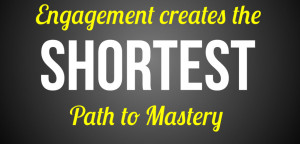10 Engaging Facts About Engagement
 Student Engagement is what I do.
Student Engagement is what I do.
I research it. Blog about it. Present about it. Make infographics about it. It’s even in my job title. All day, everyday, it’s student engagement.
My official title is “Student Engagement Technician,” but I like to think of myself as an Ideator/Innovator/Gamer/Trend Creator/Researcher/Connector/Explainer. I spend my days researching student trends—music, viral videos, websites, blogs, social media…anything and everything, trying to find ways to connect them to student learning and course development.
After a year of working on course development projects, reading countless blogs and articles, sifting through millions of gifs and memes, YouTube videos, and Pinterest pins, I’ve compiled a list of engagement tips.
I call it my “Top 10 Engaging Facts About Engagement” and I’m sharing it with you now.
 10. Engagement is Inspiring
10. Engagement is Inspiring
Think about how many times you’ve gotten on Pinterest just to find “one thing” and “by accident” you ended up staying there for more than an hour. The things you remember the most or consider most engaging are the things that inspire you.
You look at Pinterest and think “I want to do that” or or apply it to something you do. You look at the 14-year-old scientist who created a way to detect pancreatic cancer better and faster and you’re inspired. You want to know more; you want to know what motivated him and how to make more students like him. Engagement is inspiring.
 9. Engagement is Contagious
9. Engagement is Contagious
Chances are, if you are engaged as a parent or teacher, it’s more likely that your student will be, too. Your level of interest and excitement about a course directly impacts the way your student sees the course.
When I was assigned to work on the Social Media course at FLVS, I was so excited. Ecstatic. This was perfect for me. It involved something I was interested in and I felt I could make meaningful contributions because of my knowledge. It just seemed right.
Fast forward to when Social Media was completed and MJ Math needed some help. When I got tapped to help on the project, at first I was hesitant. Math was not my thing…yet. I walked into the MJ Math brainstorming session with a few ideas, but was blown away by the excitement in the room. Everyone was so pumped about redoing these courses, and came chock-full of amazing ideas. Videos, games, you name it. I couldn’t help but get excited myself. The engagement was contagious. Case in point.
 8. Engagement is Everywhere
8. Engagement is Everywhere
As adults, we are more forgivable for lack of engagement because we expect to be underwhelmed. Students, on the other hand, have little to no patience for lack of engagement. There is always an opportunity to engage, and the most difficult topics/concepts are the ones that need it the most.
Throughout your entire day, you experience engagement, and it is evident in your language, though not as apparently as you may think. Sure, you don’t say “Wow, my lunch was super engaging today.” Instead, you’d say “I would really recommend this place for lunch.” You say things like “Ugh, I wish they would stop playing this song on the radio” or “Is there really an entire hour left in this movie?” Engagement is what drives advertisements, conversations, friendships, and work ethic. It’s literally everywhere.
 7. Engagement is Authentic
7. Engagement is Authentic
Have fun and be creative with what you know, but not with what you don’t know. Be real with your engagement. Don’t pretend you listened to the Taylor Swift RED album in its entirety when you really didn’t. They’ll know. They always know.
It’s important for educators to remain authentic because when you’re not, students will notice. If you’re not really into a trend, don’t try to push it or use it. If you’re genuinely interested, take the time to learn more about it. Research it, so when it is relevant, you can speak authentically about it. Don’t be afraid to ask students questions about things they like so you can be more informed.
Just make sure you are being real. Being inauthentic will cause students to disengage. So use what you know, not what you don’t.
 6. Engagement is Positive
6. Engagement is Positive
If you haven’t been introduced to Growth Mindset yet, Google it now. It’s well worth it. Positive feedback for students is key to keeping them engaged, but it’s so much more than saying simply “Good job!” or “You’re so smart!” Engaging positivity reaches into the realm of growth mindset by challenging them to do more, try harder, and expect greater.
In a nutshell, there are two types of mindsets: a growth mindset and a fixed mindset. A fixed mindset believes intelligence is static, avoids challenges, and is threatened by others’ success. A growth mindset believes intelligence can be developed, learns through struggle, and is inspired by others’ success.
Embrace the growth mindset with your positive feedback. Be constructive and specific with your feedback so students know how and why they are growing. Any feedback is positive feedback, because it either praises their effort or gives them guidance to be better. That is, if they have a growth mindset.
 5. Engagement is Active
5. Engagement is Active
Just like active listening, there’s active engagement. It’s a conversation, a two-way street between you and the student, and it’s constantly evolving. Being actively engaging involves knowing what students like and using that as a spring board. You have to find out what interests them—what they do in their free time, what sites they visit when they’re not doing school work. Some examples of trending things that I look at are infographics, memes, viral videos, popular blogs, and buzzfeed lists.
Engagement takes effort. And the things that kids like are constantly changing, so it’s important to be active in your engagement. Keep up with the trends. Find out what’s important to them, and you’re that much closer to making that connection.
 4. Engagement is Relevant
4. Engagement is Relevant
If you have a message to deliver and there’s something current that can help you get the message across, don’t be afraid to use it. The #1 thing I hear from students is “we just want it to relate to us” or “they just don’t get us.” Remember that they see things differently than you do.
Take this for instance: 1. Work Hard 2. Be Smart 3. Don’t Give Up
How many times have you ever told a student any of these three things, and had them roll their eyes at you? Now watch this.
Ashton Kutcher says literally the exact same thing, but kids are actually listening. Why? He relates to them. He’s someone they admire and look up to. He’s attractive. He’s real. He’s speaking from experience. I could go on and on. But one of the most important things is that he was speaking to them as a peer. To them, not at them. If it takes Ashton Kutcher to get them to listen, why not? He’s relevant, and makes your message relevant, too; and not just because he’s got the jaw of a Greek god.
 3. Engagement is Simple
3. Engagement is Simple
Finding things to engage students may be the difficult part, but the delivery should always be simple. Think Twitter, Vine videos, memes. Everything is short, simple, and to the point. And students love it. It’s just enough to stick, but not ooze. The Curse of Knowledge is something we all experience when we forget what it’s like not to know something. We tend to over-explain and over-complicate things because we think that’s what’s necessary (hence, the oozing). Don’t overthink it, under-think it. See what happens. Check out the #6SecondScience Fair for an example of awesome, simplistic engagement.
 2. Engagement Creates the Shortest Path to Mastery
2. Engagement Creates the Shortest Path to Mastery
Engagement truly does create the shortest path to mastery. Use an example that students know to explain something they don’t know.
The more they can relate to the example, the easier it is for them to understand a difficult concept.
Once you’ve established that connection, that common meeting point, then you can progress.
 1. Engagement is Not Distraction
1. Engagement is Not Distraction
This is my favorite, thus #1 and final on my list. If you take away anything from these 10 facts, I would say choose this one: Engagement is NOT distraction.
Knowing the difference is crucial to creating a connection with your students and using what they know and like to their learning advantage. It ties in being authentic, simple, active—every other engagement rule—to ensure that your student engagement methods aid their learning, not distract from it.
Engagement is defined as something that occupies, attracts or involves one’s attention. That’s easy part. But here at FLVS, we are looking to go a step further. We want to get their attention, AND apply it to Math, Language Arts, Science, and Social Studies. If you tell a student that Justin Bieber is traveling at a velocity of 75mph for 30 minutes, and then ask them to calculate how far he traveled, chances are, they’re going to ask you if he had a shirt on or not. Was his hair tousled? OMG I loved his new song. And his new tattoo? Don’t even get me started… And then they’re lost. Distracted.
It’s about finding the unique balance of student interest and relevance to the content. In some cases, you’ve got a wide berth, and other times, it’s a very fine line. All students are different. But think to yourself, is this really teaching them something? Or is it a stretch? Ask yourself if you would be engaged (remember #9 Engagement is Contagious). Figure out what the principles, approaches, and elements of sticky trends are; why do students like it? And apply those pieces. Use examples if you can find them, but make sure they fit with what you are trying to teach them.
So there you have it. Go forth, and engage. Be engaged. Want more? Visit my blog! For even more on engaging tips, see my Pinterest.
Michelle Nguyen works on the Curriculum Services team at Florida Virtual School. As the Student Engagement Technician, she provides the student perspective for course development by immersing herself in the latest internet trends, conducting student market research and keeping a blog and other resources to keep her team connected to what students like.
